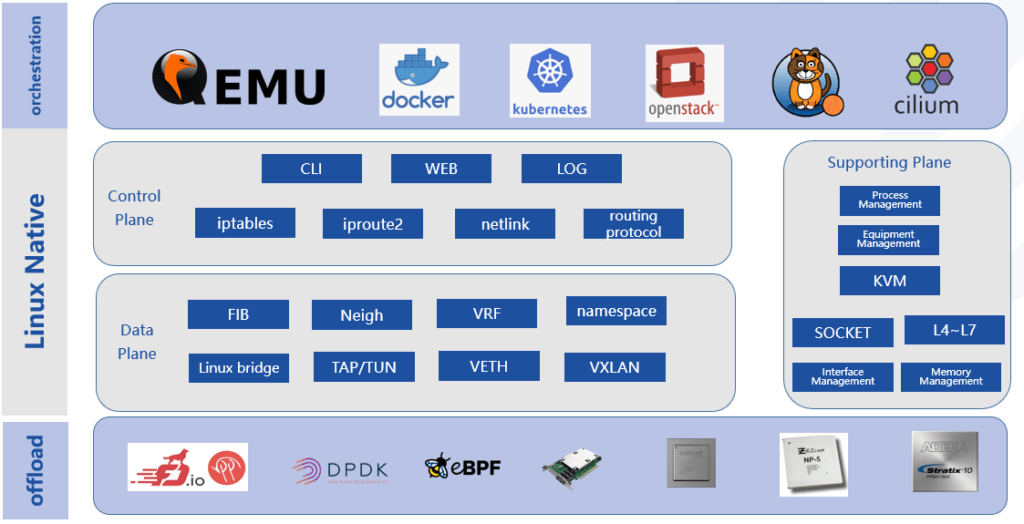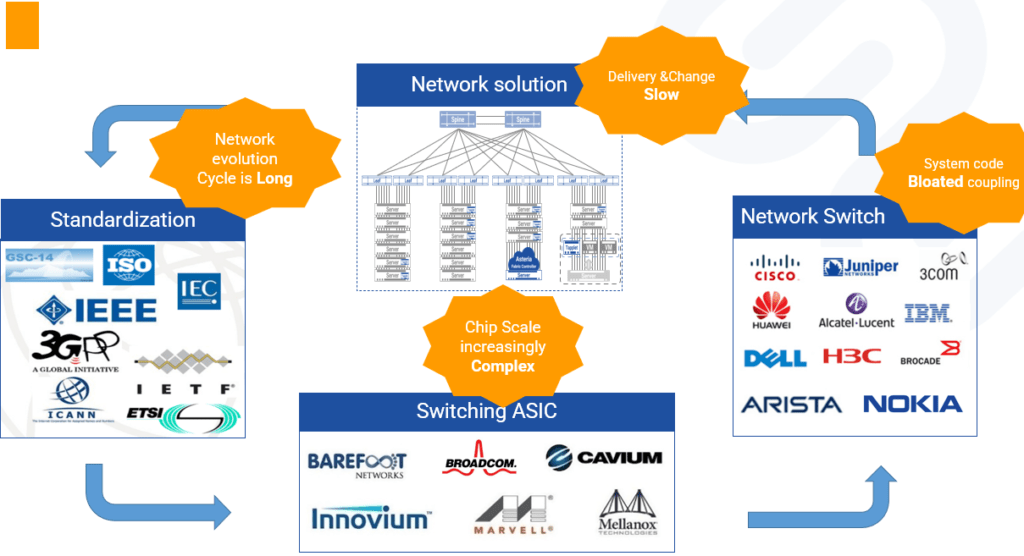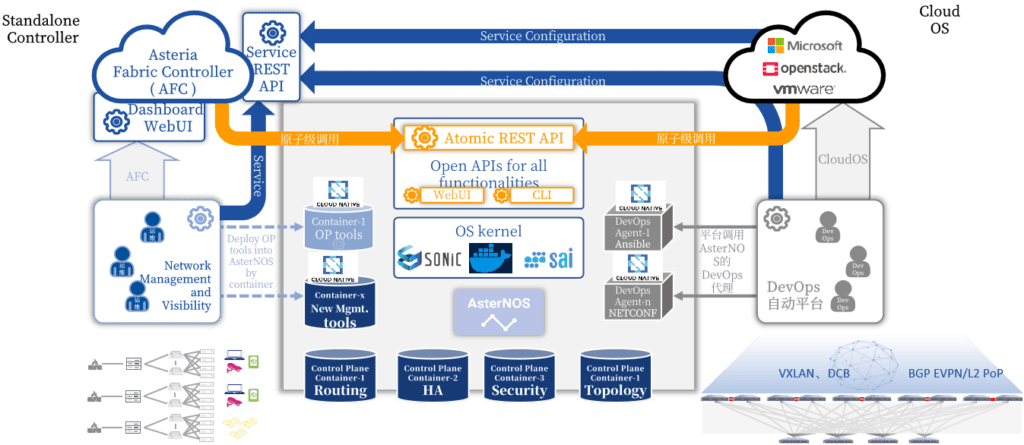How Open Source Promotes High-quality Evolution of Open Networking
written by Asterfuison
Recently, the “2022 China Optical Communication High Quality Development Forum —-All-Optical Data Center Online Seminar” hosted by China International Optoelectronic Exposition (CIOE) and C114 came to an end.Mingyu Li, vice president and head of R&D department of Asterfusion, gave a speech with the theme of “Open Source Technology promotes high-quality evolution of Open Network“, which elaborated how open source technology promotes high-quality evolution of network from the perspective of network equipment.
To make it easier to understand Mingyu Li’s speech, let us clarify following concepts:
What is open-source network, open network and SDN (software-defined networking)
What is Open source network
open source is software or program available for using and modification by the public, while open networks are based on software designed to create more flexibility, convenience, reliability, and automation for network devices. Something can be open source, but not the open networks, and vice versa. In addition, software-defined can be both open source and open networks, or neither.
What is Open networking
Open networks are based on open standards (such as the OpenFlow protocol) and bare metal hardware (whitebox hardware), with a flexible choice of network operating system (NOS). It designed to realize the disaggregation of software and hardware, and provide a flexible, scalable and programmable network to meet the application requirements of different scenarios. Therefore, open networking ‘s users can freely choose their operating system and hardware. This makes their business more agile, more cost-effective and faster to market, which the trend is inevitable.
What is SDN (Software-defined Networking)
SDN (software-defined networking) is often seen as an architecture that can separate the control plane from the data plane. One of the main components of SDN is the SDN controller, which can communicate with applications through northbound application programming interfaces (APIs) and with switches or routers using southbound interfaces such as OpenFlow.
Most current SDN architectures use proprietary or open-source software on third-party or commercial hardware. Therefore, SDN allows for open networks, which has led some people to believe that SDN is also open source. Actually, SDN can be done without the open network environment. SDN can achieve functional separation, network virtualization and automation through programmability, but it is not open source itself.
In general, open-source means that something is publicly accessible. It usually refers to open source software or open source programs, the source code of which can be used, modified, and shared by anyone.The rapid development of the Internet has spawned many requirements for source code rewriting. By opening the source code to the public, it’s more convenient for more professionals to view, learn, share and improve the network code, and optimize the network environment. In order to achieve specific software development, many large operators, service providers, professional engineers have joined the open source project, the trend is unstoppable as well.
Open Source promotes high-quality evolution of Open Network
At the seminar, Mingyu Li, said that the network plays a key role in the stable operation of the data center, and open source and open networks are undoubtedly the big trend of the industry in recent years.
With the gradual development of applications hosted by data centers from Monolithic architecture to cloud native architecture, various open source network technologies have been widely applied and matured, and their stability has been fully verified. The development and delivery of high-quality network devices has become a new trend in open networking based on these widely proven native open source technologies.
The open source network stack is mature and stable enough
Mingyu Li said that in the era of the “Internet of Everything”, due to the continuous changes in the connection methods between people, things, and applications/services, the application architecture has developed from the early monolithic architecture and layered cluster architecture to the current SOA (Service Oriented Architecture)/microservice architecture and cloud native architecture.

The evolution of application architectures has also brought about changes in data center architectures — from centralized and virtualized data centers to cloud data centers and cloud native data centers, with iterative upgrades in terms of functionality, storage, connectivity, and delivery capabilities.

First of all, in the process of continuously satisfying the requirements of network technology for applications, the open source and open network operating system with Linux as the core has been proved to be standard, stable, able to support rapid iteration of applications, and better able to adapt to the development of data center applications.
On the other hand, when modern applications promote the evolution of network technology, the mainstream approach is to keep Linux native open source network technology to iterate. In addition, the existing technical architecture is open enough in terms of offloading and accelerating the data plane.
The hardware’s data plane needs to evolve
Mingyu Li believes that network development should be not limited to the software level. Based on this point of view, in hardware scenarios, such as the application of switches and switching chips in open networking is a key issue that needs to be discussed.
The traditional network industry covers a vast industry chain, Firstly, the hardware switching chip is usually formed from standardization, and then based on their standardized chip, the equipment or system vendors make the device to generate network solutions. However, it also brings many problems, such as network evolution, long cycle, chip scale, increasing complexity, system code, bloated coupling, slow delivery and change, etc.

In the cloud network era, the hardware data plane urgently needs to learn from the iterative speed of open source and open software network to solve traditional problems.
Open networking roadmap in the future
Open networks are derived from SDN, including open software and open hardware, that is, the hardware needs standardized technical architecture (switching ASIC +CPU+BMC), and supports the installation of third-party NOS and APP, while the software is compatible with open white box hardware and application-level operation and maintenance capabilities.
After more than ten years of development, the open network ecosystem has become increasingly mature, from chips to cloud industry, it includes almost all mainstream players including Microsoft, Facebook, and HP, and is widely used from the Internet to operators and other large data centers. At the same time, software and hardware manufacturers both have got different degrees of development. Asterfusion can not only deliver software and hardware, but also whole machine delivery, which is uncommon in the worldwide.

It should also be noted that there are plenty of network operating system platforms based on Linux or in-depth customized on top of Linux. But from the later development and evolution process, various problems may be encountered in terms of quality and standardization. Therefore, Mingyu Li said that the technical route of based on the Linux native protocol stack as the core and the SAI interface as the adaptation layer, which is the main development trend of open networks in the future.
The value of open networks: standard and mature network protocol stack
Mingyu Li also said that the value of an open networks lies in a standard and mature network protocol stack, which is the basis for high-quality sustainable development. At the same time, for the application architecture evolution capability, system flexibility can be iterated synchronously with the host network. What’s more, the hardware abstraction layer interface is based on industry consensus and can quickly import various data plane acceleration technologies.

In other words, open networks are not only software decoupling, but also an agile, high-quality development and delivery model for network equipment. It is under this mode that Asterfusion has built a series of product solutions for data centers, including “Commercial SONiC distribution– AsterNOS, Tofino-based P4 programmable open platform ,Teralynx -based cloud network switching platform and Marvell octeon TX baed ARM64 appliance series products, which have received many favorable comments from customers in various industries.

By 2021, Asterfusion has helped redefine the network infrastructure framework for more than 150 customers worldwide. At the same time, Asterfusion also cooperates with China Unicom Research Institute, Alibaba and Meituan and many other enterprises in the industry to jointly lead and promote the development of open network ecology.
In the future, Asterfusion will continue to carry out technological innovation and product exploration in the open networking and contribute to the high-quality development of the digital society.
Joining us with this revolution, as we are paving the way into the future of open networking.
Reference:



